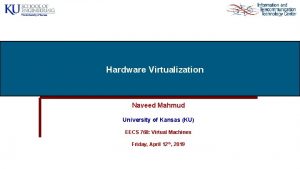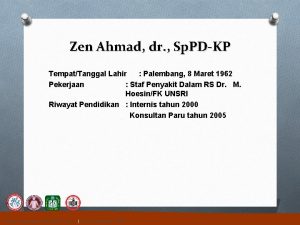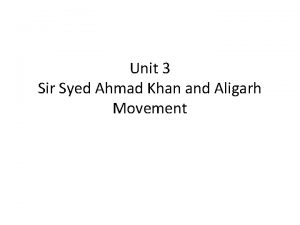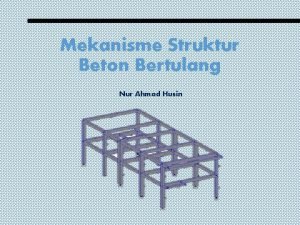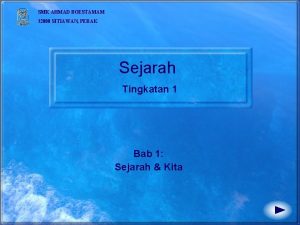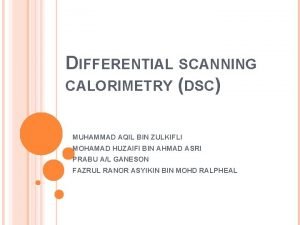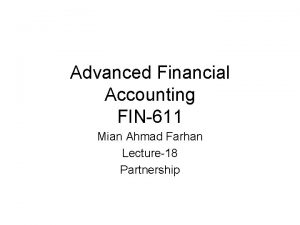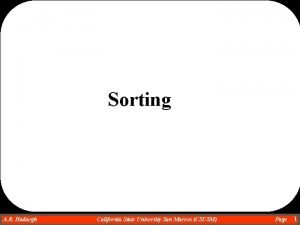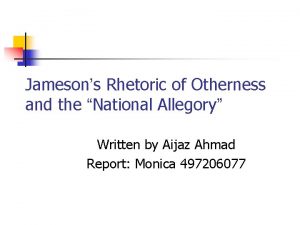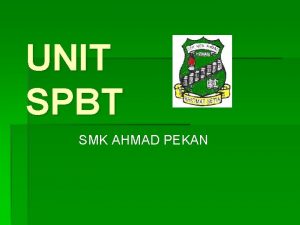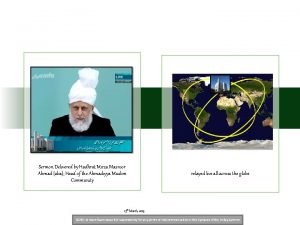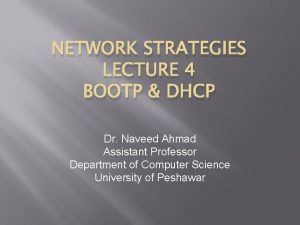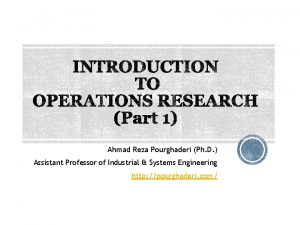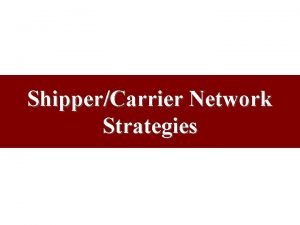NETWORK STRATEGIES Dr Naveed Ahmad Assistant Professor Department






















































- Slides: 54

NETWORK STRATEGIES Dr. Naveed Ahmad Assistant Professor Department of Computer Science University of Peshawar

What is Protocol � � � A standard that allows entities (i. e. application programs) from different systems to communicate Shared conventions for communicating information Includes syntax, semantics, and timing

Standardized Protocol Architectures � � � Vendors like standards because they make their products more marketable Customers like standards because they enable products from different vendors to interoperate Two protocol standards are well-known: � TCP/IP: widely implemented � OSI: less used, still useful for modeling/conceptualizing

Internet Standards � Email related standards � � Web related standards � � X. 500, LDAP Application standards � � http, CGI, html/xml/vrml/sgml Internet directory standards � � IMAP, POP, X. 400, SMTP, CMC, MIME, binhex, uuencode http, FTP, telnet, gopher, wais Videoconferencing standards � H. 320, H. 323, Mpeg-1, Mpeg-2

Telecommunication Standards Organizations � � � � � International Telecommunications Union Telecommunication Standardization Sector (ITU-TSS). Formerly called the Consultative Committee on International Telegraph and Telephone (CCITT) International Organization for Standards (ISO). Member of the ITU, makes technical recommendations about data communications interfaces. American National Standards Institute (ANSI) Institute of Electrical and Electronics Engineers (IEEE) Internet Engineering Task Force (IETF) Electronic Industries Association (EIA) National Institute of Standards and Technology (NIST) National Exchange Carriers Association (NECA) Corporation for Open Systems (COS) Electronic Data Interchange -(EDI) of Electronic Data Interchange for Administration Commerce and Transport (EDIFACT).

Internet Engineering Task Force A protocol proposed by a vendor IETF working group study the proposal IETF issues a request for comment (RFC) IETF reviews the comments IETF proposes an improved RFC The RFC becomes a proposed standard The proposed standard becomes a draft standard if two or more vendors adopt it

What is Network � A network consists of 2 or more computers connected together, and they can communicate and share resources (e. g. information)

Why Networking? � Sharing information — i. e. data communication

How many kinds of Networks? • Depending on one’s perspective, we can classify networks in different ways. • Based on transmission media: Wired (UTP, coaxial cables, fiber-optic cables) and Wireless • Based on network size: LAN and WAN (and MAN) • Based on management method: Peer-to-peer and Client/Server • Based on topology (connectivity): Bus, Star, Ring …

What is OSI? � � Developed by the International Organization for Standardization (ISO) in 1984 The primary architectural model for inter computer communications. A conceptual model composed of seven layers, each specifying particular network functions. Describes how information from a software application in one computer moves through a network medium to a software application in another computer.

OSI

Postal Analogy-1

Postal Analgoy-2 Application � A- Write a 20 page letter to a foreign country. Presentation � P- Translate the letter so the receiver can read it. Session � S- Insure the intended recipient can receive letter. � T- Separate and number pages. Like registered mail, tracks delivery and requests another package if one is “lost” or “damaged” in the mail. N- Postal Center sorting letters by zip code to route them closer to destination. D- Local Post Office determining which vehicles to deliver letters. P- Physical Trucks, Planes, Rail, autos, etc which carry letter between stations. Transport Network Data-Link � � � Physical

Layers-1

Layers-2

Layers-3

Layers-4

What is TCP/IP? � � Transmission control Protocol/Internet Protocol Developed by DARPA No official protocol standard Can identify five layers � Application � Host-to-Host (transport) � Internet � Network Access (Physical Layer)

TCP/IP Layers Layer Protocols Application HTTP Transport TCP TELNET Internet Network Access (Host-to-network) SMTP SNMP UDP IP ETHERNET FTP ICMP PACKET RADIO

Network Access Layer � Concerned with all of the issues that an IP packet requires to actually make the physical link. All the details in the OSI physical and data link layers. � Electrical, mechanical, procedural and functional specifications. � Data rate, Distances, Physical connector. � Frames, physical addressing. � Synchronization, flow control, error control.

Internet Layer � Send source packets from any network on the internetwork and have them arrive at the destination independent of the path and networks they took to get there. � Packets, Logical addressing. � Internet Protocol (IP). � Route , routing table, routing protocol.

Transport Layer � The transport layer deals with the quality-ofservice issues of reliability, flow control, and error correction. � Segments, data stream, datagram. � Connection oriented and connectionless. � Transmission control protocol (TCP). � User datagram protocol (UDP). � End-to-end flow control. � Error detection and recovery.

Application Layer � � Handles high-level protocols, issues of representation, encoding, and dialog control. The TCP/IP combines all application-related issues into one layer, and assures this data is properly packaged for the next layer. � FTP, HTTP, SMNP, DNS. . . � Format of data, data structure, encode … � Dialog control, session management …

Packet Encapsulation 22 Bytes 20 Bytes 64 to 1500 Bytes 4 Bytes

Comparison of OSI and TCP/IP

General Concept � OSI: Open Systems Interconnection. It was developed by ISO as a first step toward international standardization of the protocol used in various layers. It deals with connecting open system. � TCP/IP: Transport Control Protocol/Internet Protocol. TCP is used in connection with IP and operates at the transport layer. IP is the set of convention used to pass packets from one host to another.

Similarity � � Both are based on the concept of a stack of independent protocols. The functionality of the layers is roughly similar.

Differences-1 � � OSI makes the distinction between services, interfaces, and protocol. The OSI model was devised before the protocols were invented. It can be made to work in diverse heterogeneous networks. � � TCP/IP does not originally clearly distinguish between services, interface, and protocol. TCP/IP model was just a description of the existing protocols. The model and the protocol fit perfectly.

Differences-2 � The OSI model supports both connectionless and connection-oriented communication in the network layer, but only connectionoriented communication in the transport layer. � The TCP/IP model has only one mode in the network layer (connectionless) but supports both modes in the transport layer, giving the user choice.

Differences-3 � OSI emphasis on providing a reliable data transfer service, Each layer of the OSI model detects and handles errors, all data transmitted includes checksums. The transport layer checks sourcedestination reliability. � TCP/IP treats reliability as an end to end Problem. The transport layer handles all error detection and recovery, it was checksums, acknowledgments, and timeouts to control transmissions and provides end-toend verification.

Differences-4 � Host on OSI implementations do not handle network operations. OSI Model 7 th Application Layer 6 th Presentation Layer 5 th Session Layer 4 th Transport Layer 3 rd Network Layer 2 nd Link Layer 1 st Physical Layer TCP/IP Hierarchy Application Layer Transport Layer Network Layer Link Layer � TCP/IP hosts participate in most network protocols. Protocols

Upper layers � � � Session Presentation Application OSI TCP / IP Application (Layer 7) Presentation (Layer 6) Session (Layer 5) Application

The Session Layer � � � The Session layer permits two parties to hold ongoing communications called a session across a network. Not found in TCP/IP model In TCP/IP, its characteristics are provided by the TCP protocol. (Transport Layer)

The Presentation Layer � � � The Presentation Layer handles data format information for networked communications. This is done by converting data into a generic format that could be understood by both sides. Not found in TCP/IP model In TCP/IP, this function is provided by the Application Layer. e. g. External Data Representation Standard (XDR) Multipurpose Internet Mail Extensions (MIME)

The Application Layer � The Application Layer is the top layer of the reference model. It provides a set of interfaces for applications to obtain access to networked services as well as access to the kinds of network services that support applications directly. � OSI - FTAM, VT, MHS, DS, CMIP TCP/IP - FTP, SMTP, TELNET, DNS, SNMP � Although the notion of an application process is common to both, their approaches to constructing application entities is different.

Transport Layer-1 � The functionality of the transport layer is to provide “transparent transfer of data from a source end open system to a destination end open system” (ISO / IEC 7498: 1984). OSI Transport (Layer 4) TCP / IP Transport (TCP/UDP)

Transport Layer-2 � The features of UDP and TCP defined at TCP/IP Transport Layer correspond to many of the requirements of the OSI Transport Layer. There is a bit of bleed over for requirements in the session layer of OSI since sequence numbers, and port values can help to allow the Operating System to keep track of sessions, but most of the TCP and UDP functions and specifications map to the OSI Transport Layer.

Transport Layer-3 � The TCP/IP and OSI architecture models both employ all connection and connectionless models at transport layer. However, the internet architecture refers to the two models in TCP/IP as simply “connections” and datagrams. But the OSI reference model, with its penchant for “precise” terminology, uses the terms connection-mode and connection-oriented for the connection model and the term connectionless-mode for the connectionless model.

Network vs. Internet-1 � Like all the other OSI Layers, the network layer provides both connectionless and connectionoriented services. As for the TCP/IP architecture, the internet layer is exclusively connectionless. OSI Network (Layer 3) TCP / IP Internet

Network vs. Internet-2 � X. 25 Packet Level Protocol – OSI’s Connection-oriented Network Protocol The CCITT standard for X. 25 defines the DTE/DCE interface standard to provide access to a packet-switched network. It is the network level interface, which specifies a virtual circuit (VC) service. A source host must establish a connection (a VC) with the destination host before data transfer can take place. The network attempts to deliver packets flowing over a VC in sequence.

Network vs. Internet-3 � Connectionless Network Service � Both OSI and TCP/IP support a connectionless network service: OSI as an alternative to network connections and TCP/IP as the only way in use. � Internetworking Protocols � OSI’s CLNP (ISO/IEC 8473: 1993) is functionally identical to the Internet’s IP (RPC 791). Both CLNP and IP are best-effort-delivery network protocols. Bit niggling aside, they are virtually identical. The major difference between the two is that CLNP accommodates variable-length addresses, whereas IP supports fixed, 32 -bit address.

Network vs. Internet-4 � Internet (IP) Addresses � The lnternet network address is more commonly called the “IP address. ” It consists of 32 bits, some of which are allocated to a high-order network-number part and the remainder of which are allocated to a low-order host-number part. The distribution of bits how many form the network number, and how many are therefore left for the host number - can be done in one of three different ways, giving three different classes of IP address

Network vs. Internet-5 � OSI Network Layer Addressing � ISO/IEC and CCITT jointly administer the global network addressing domain. The initial hierarchical decomposition of the NSAP address is defined by (ISO/IEC 8348). The standard specifies the syntax and the allowable values for the high-order part of the address - the Initial Domain Part (IDP), which consists of the Authority and Format Identifier (AFI) and the Initial Domain Identifier (IDI) - but specifically eschews constraints on or recommendations concerning the syntax or semantics of the domain specific part (DSP).

Network vs. Internet-6 � OSI Routing Architecture � End systems (ESs) and intermediate systems (ISs) use routing protocols to distribute (“advertise”) some or all of the information stored in their locally maintained routing information base. ESs and ISs send and receive these routing updates and use the information that they contain (and information that may be available from the local environment, such as information entered manually by an operator) to modify their routing information base.

Network vs. Internet-7 � TCP/IP Routing Architecture � The TCP/IP routing architecture looks very much like the OSI routing architecture. Hosts use a discovery protocol to obtain the identification of gateways and other hosts attached to the same network (subnetwork). Gateways within autonomous systems (routing domains) operate an interior gateway protocol (intradomain IS-IS routing protocol), and between autonomous systems, they operate exterior or border gateway protocols (interdomain routing protocols). The details are different but the principles are the same.

Data link / Physical vs. Subnet-1 § Data link layer § The function of the Data Link Layer is “provides for the control of the physical layer, and detects and possibly corrects errors which may occur” (IOS/IEC 7498: 1984). In another words, the Data Link Layer transforms a stream of raw bits (0 s and 1 s) from the physical into a data frame and provides an error-free transfer from one node to another, allowing the layers above it to assume virtually error-free transmission OSI TCP / IP Data Link (Layer 2) Subnet Physical (Layer 1)

Data link / Physical vs. Subnet-2 � Comparing to TCP/IP � These 2 layers of the OSI correspond directly to the subnet layer of the TCP/IP model. � Majority of the time, the lower layers below the Interface or Network layer of the TCP/IP model are seldom or rarely discussed. The TCP/IP model does nothing but to high light the fact the host has to connect to the network using some protocol so it can send IP packets over it. Because the protocol used is not defines, it will vary from host to host and network to network

Data link / Physical vs. Subnet-3 � Comparing to TCP/IP � After much deliberation by organizations, it was decided that the Network Interface Layer in the TCP/IP model corresponds to a combination of the OSI Data Link Layer and network specific functions of the OSI network layer (eg IEEE 203. 3). � Since these two layers deal with functions that are so inherently specific to each individual networking technology, the layering principle of grouping them together related functions is largely irrelevant.

Focus of Reliability Control � � � Implementation of the OSI model places emphasis on providing a reliable data transfer service, while the TCP/IP model treats reliability as an end-to-end problem. Each layer of the OSI model detects and handles errors, all data transmitted includes checksums. The transport layer of the OSI model checks source-to-destination reliability. In the TCP/IP model, reliability control is concentrated at the transport layer. The transport layer handles all error detection and recovery. The TCP/IP transport layer uses checksums, acknowledgments, and timeouts to control transmissions and provides end-to-end verification.

Roles of Host System � Hosts on OSI implementations do not handle network operations (simple terminal), but TCP/IP hosts participate in most network protocols. TCP/IP hosts carry out such functions as end-to-end verification, routing, and network control. The TCP/IP internet can be viewed as a data stream delivery system involving intelligent hosts.

De-jure vs. De-facto (OSI) � OSI Standard legislated by official recognized body. (ISO) � The OSI reference model was devised before the protocols were invented. This ordering means that the model was not biased toward one particular set of protocols, which made it quite general. The down side of this ordering is that the designers did not have much experience with the subject and did not have a good idea of which functionality to put in which layer. � Being general, the protocols in the OSI model are better hidden than in the TCP/IP model and can be replaced relatively easily as the technology changes. � Not so widespread as compared with TCP/IP. (complex , costly) � More commonly used as teaching aids. �

De-jure vs. De-facto (TCP/IP) � TCP/IP Standards adopted due to widespread use. (Internet) � The protocols came first, and the model was really just a description of the existing protocols. There was no problem with the protocols fitting the model, but it is hardly possible to be use to describe other models. � “Get the job done" orientation. Over the years it has handled most challenges by growing to meet the needs. � More popular standard for internetworking for several reasons : � relatively simple and robust compared to alternatives such as OSI available on virtually every hardware and operating system platform (often free) the protocol suite on which the Internet depends.

Summary of OSI and TCP/IP

 Naveed mahmud
Naveed mahmud Naveed arshad lums
Naveed arshad lums Song
Song Promotion from assistant to associate professor
Promotion from assistant to associate professor Fok ping kwan
Fok ping kwan Vostrine
Vostrine Risala asbab-i-baghawat-i-hind
Risala asbab-i-baghawat-i-hind What is duty cycle
What is duty cycle Dr fawad randhawa
Dr fawad randhawa Jawad ahmad md
Jawad ahmad md Nur ahmad husin
Nur ahmad husin Ahmad israiwa
Ahmad israiwa Neurosis vs psychosis
Neurosis vs psychosis Seitz filter funnel
Seitz filter funnel Dr nur ahmad tabri
Dr nur ahmad tabri Nur ahmad husin
Nur ahmad husin Nur ahmad husin
Nur ahmad husin Ibrahim primary school
Ibrahim primary school Ahmad boestamam sejarah tingkatan 4
Ahmad boestamam sejarah tingkatan 4 Pengenalan pengakap
Pengenalan pengakap Yamin ahmad
Yamin ahmad Hadi ahmad md
Hadi ahmad md Kussmaul sign
Kussmaul sign Rosli bin ahmad
Rosli bin ahmad Dr waseem ibrahim
Dr waseem ibrahim Dr armen ahmad
Dr armen ahmad Ahmad rafiki
Ahmad rafiki Dsc principle and instrumentation
Dsc principle and instrumentation Ahmad rafay alam
Ahmad rafay alam Dr ahmad faisal
Dr ahmad faisal Mian ahmad farhan
Mian ahmad farhan Rabiah ahmad
Rabiah ahmad Aflatoon kite runner
Aflatoon kite runner Ahmad hadaegh
Ahmad hadaegh Dr shahzad ahmad
Dr shahzad ahmad National allegory examples
National allegory examples Dr ani binti ahmad
Dr ani binti ahmad Smk ahmad pekan
Smk ahmad pekan Ahmad aulia jusuf
Ahmad aulia jusuf Dr mirza ahmad
Dr mirza ahmad Kompetensi manajerial kepala perpustakaan
Kompetensi manajerial kepala perpustakaan Minimal change disease treatment
Minimal change disease treatment Ahmad aulia jusuf
Ahmad aulia jusuf Pasti
Pasti Authoritative style of leadership
Authoritative style of leadership Fouzia khursheed ahmad
Fouzia khursheed ahmad Ahmad aulia jusuf
Ahmad aulia jusuf Reported speech examples
Reported speech examples Cerpen ibu
Cerpen ibu Ahmad makki hasan
Ahmad makki hasan Sayed ahmad salehi
Sayed ahmad salehi Characteristics of a good research
Characteristics of a good research Ahmad kamal
Ahmad kamal Dr. ahmad muchlis
Dr. ahmad muchlis Cstr in parallel
Cstr in parallel
